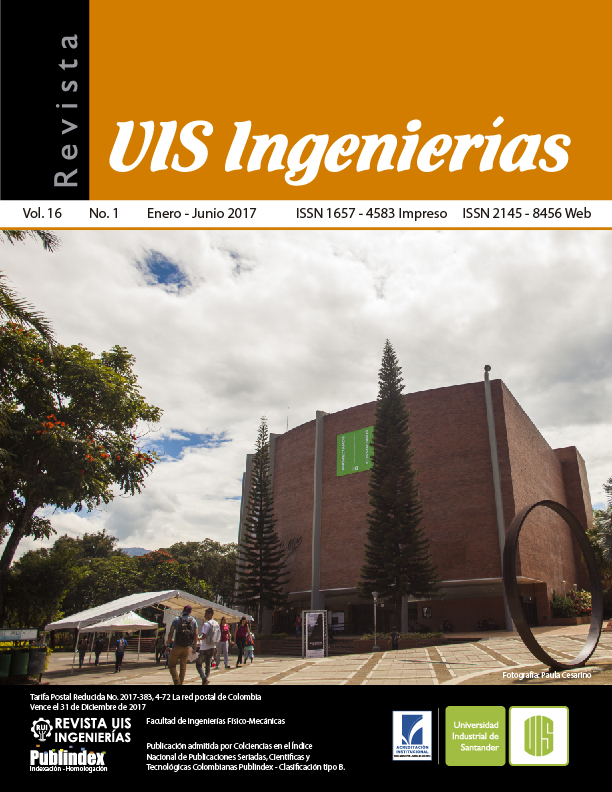Stress recovery for the polygonal finite element method
Published 2016-12-27
Keywords
- Finite element method,
- polygonal elements,
- error estimation,
- estress recovery,
- adaptivity
- moving least squares ...More
How to Cite
Abstract
The finite element method is one of the most used numerical tools for engineering design. In recent years, novel numerical approximations have been proposed to extend the finite element method to meshes using arbitrary polygons. Such approximations are aimed to improve accuracy and increase the flexibility during the meshing process. However, as any approximation, they exhibit an error that requires to be quantified in order to validate the numerical results. In this paper, we present a technique to estimate the discretization error in energy norm for arbitrary polygonal finite element meshes. This recovery-based technique uses a moving least squares approach that considers constraints to represent the equilibrium equations. We use two benchmark problems to evaluate the effectivity of the error estimator, with good results both locally and globally.
Downloads
References
- M. Kraus, A. Rajagopal, and P. Steinmann, “Investigations on the polygonal finite element method: Constrained adaptive Delaunay tessellation and conformal interpolants,” Comput. Struct., vol. 120, pp. 33–46, 2013.
- K. Jayabal, A. Menzel, A. Arockiarajan, and S. M. Srinivasan, “Micromechanical modelling of switching phenomena in polycrystalline piezoceramics: application of a polygonal finite element approach,” Comput. Mech., vol. 48, pp. 421–435, 2011.
- P. Pavankumar, K. Jayabal, and A. Arockiarajan, “A comparative study between finite element and polygonal finite element approaches for electromechanical coupled linear problems,” Intergrated Ferroelectr., vol. 120, pp. 90–101, 2010.
- K. Y. Sze and N. Sheng, “Polygonal finite element method for nonlinear constitutive modeling of polycrystalline ferroelectrics,” Finite Elem. Anal. Des., vol. 42, no. 2, pp. 107–129, 2005.
- E. L. Wachspress, “A rational basis for function approximation,” Lect. notes Math., 1971.
- G. Dasgupta, “Interpolants within Convex Polygons: Wachspress’ Shape Functions,” ASCE - J. Aerosp. Eng., vol. 16, no. 1, pp. 1–8, 2003.
- N. Sukumar and E. A. Malsch, “Recent Advances in the Construction of Polygonal Finite Element Interpolants,” Arch. Comput. Methods Eng., vol. 13, no. 1, pp. 129–163, 2006.
- M. Arroyo and M. Ortiz, “Local Maximum-Entropy Approximation Schemes,” Lect. notes Comput. Sci. Eng., vol. 57, p. 1, 2006.
- N. Sukumar and A. Tabarraei, “Conforming polygonal finite elements,” Int. J. Numer. Methods Eng., vol. 61, no. 2045–2066, pp. 2045–2066, 2004.
- M. M. Rashid and P. M. Gullet, “On a finite element method with variable element topology,” Comput. Methods Appl. Mech. Eng., vol. 190, no. 11–12, pp. 1509–1527, 2000.
- S. Ghosh and Y. Liu, “Voronoi cell finite element model based on micropolar theory of thermoelasticity for heterogeneous materials,” Int. J. Numer. Methods Eng., vol. 38, no. 8, pp. 1361–1398, Apr. 1995.
- S. Ghosh and S. Moorthy, “Elastic-plastic analysis of arbitrary heterogeneous materials with the Voronoi Cell finite element method,” Comput. Methods Appl. Mech. Eng., vol. 121, no. 1–4, pp. 373–409, 1995.
- X. H. Tang, S. C. Wu, C. Zheng, and J. H. Zhang, “A novel virtual node method for polygonal elements,” Appl. Math. Mech., vol. 30, no. 10, pp. 1233–1246, 2009.
- L. da Veiga, F. Brezzi, A. Cangiani, G. Manzini, L. D. Marini, and A. Russo, “Basic principles of virtual element methods,” Math. Model. Methods Appl. Sci., vol. 23, p. 199, Nov. 2013.
- B. A. Szabó and I. Babuška, Finite Element Analysis. New York: John Wiley & Sons, 1991.
- O. A. González-Estrada, J. Leal Enciso, and J. D. Reyes Herrera, “Análisis de integridad estructural de tuberías de material compuesto para el transporte de hidrocarburos por elementos finitos.,” UIS Ing., vol. 15, no. 2, pp. 105–116, 2016.
- J. J. Ródenas, O. A. González-Estrada, J. E. Tarancón, and F. J. Fuenmayor, “A recovery-type error estimator for the extended finite element method based on singular+smooth stress field splitting,” Int. J. Numer. Methods Eng., vol. 76, no. 4, pp. 545–571, 2008.
- O. A. González-Estrada, S. Natarajan, J. J. Ródenas, H. Nguyen-Xuan, and S. P. A. Bordas, “Efficient recovery-based error estimation for the smoothed finite element method for smooth and singular linear elasticity,” Comput. Mech., vol. 52, no. 1, pp. 37–52, Sep. 2013.
- M. Ainsworth and J. T. Oden, A posteriori Error Estimation in Finite Element Analysis. Chichester: John Wiley & Sons, 2000.
- J. J. Ródenas, O. A. González-Estrada, F. J. Fuenmayor, and F. Chinesta, “Enhanced error estimator based on a nearly equilibrated moving least squares recovery technique for FEM and XFEM,” Comput. Mech., vol. 52, no. 2, pp. 321–344, Aug. 2013.
- R. Sibson, “A vector identity for the Dirichlet tessellation,” Math. Proc. Cambridge Philos. Soc., vol. 87, no. 01, p. 151, 1980.
- O. C. Zienkiewicz and J. Z. Zhu, “A simple error estimator and adaptive procedure for practical engineering analysis,” Int. J. Numer. Methods Eng., vol. 24, no. 2, pp. 337–357, 1987.
- G. R. Liu, “MFree Shape Function Construction,” in Mesh Free Methods. Moving beyond the Finite Element Method, Boca Ratón, Florida: CRC Press, 2003, p. 693.
- P. Díez, J. J. Ródenas, and O. C. Zienkiewicz, “Equilibrated patch recovery error estimates: simple and accurate upper bounds of the error,” Int. J. Numer. Methods Eng., vol. 69, no. 10, pp. 2075–2098, 2007.
- J. J. Ródenas, M. Tur, F. J. Fuenmayor, and A. Vercher, “Improvement of the superconvergent patch recovery technique by the use of constraint equations: the SPR-C technique,” Int. J. Numer. Methods Eng., vol. 70, no. 6, pp. 705–727, 2007.
- J. J. Ródenas, O. A. González-Estrada, P. Díez, and F. J. Fuenmayor, “Accurate recovery-based upper error bounds for the extended finite element framework,” Comput. Methods Appl. Mech. Eng., vol. 199, no. 37–40, pp. 2607–2621, 2010.
- A. Huerta, Y. Vidal, and P. Villon, “Pseudo-divergence-free element free Galerkin method for incompressible fluid flow☆,” Comput. Methods Appl. Mech. Eng., vol. 193, no. 12–14, pp. 1119–1136, 2004.
- Q. Z. Xiao and B. L. Karihaloo, “Statically admissible stress recovery using the moving least squares technique,” in Progress in Computational Structures Technology, 2004, pp. 111–138.

